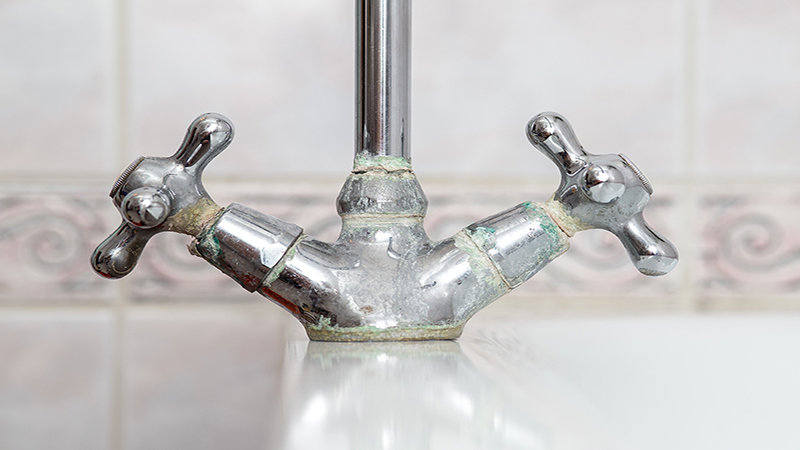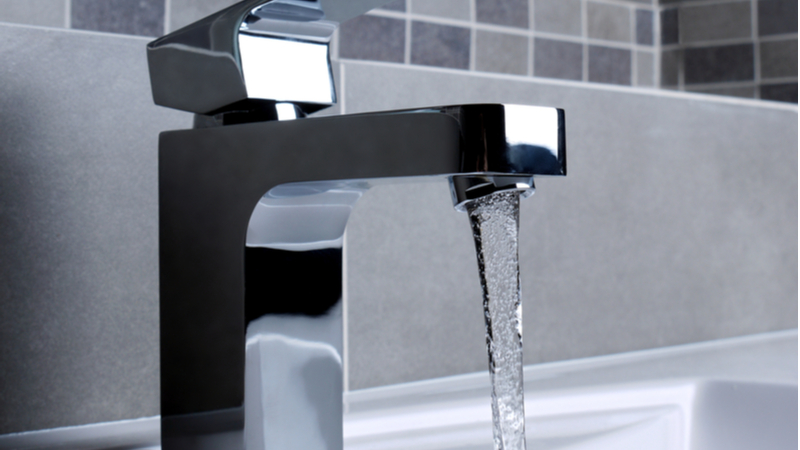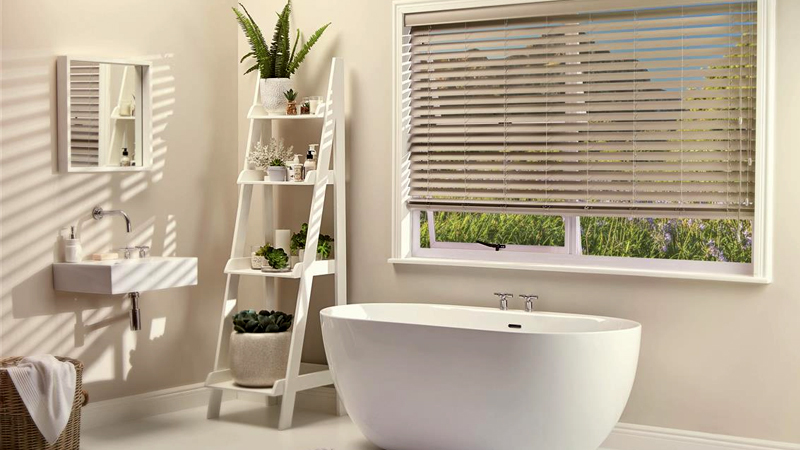Best Bathroom Extractor Fan

More often than not, our homes can become hot and stuffy, which can affect the structural materials and items within them.
When this problem arises, it can create a breeding ground for mould and cause other detrimental issues such as peeling paint and rusting metal materials inside the premises. This is especially apparent within the wettest room in the house - the bathroom.
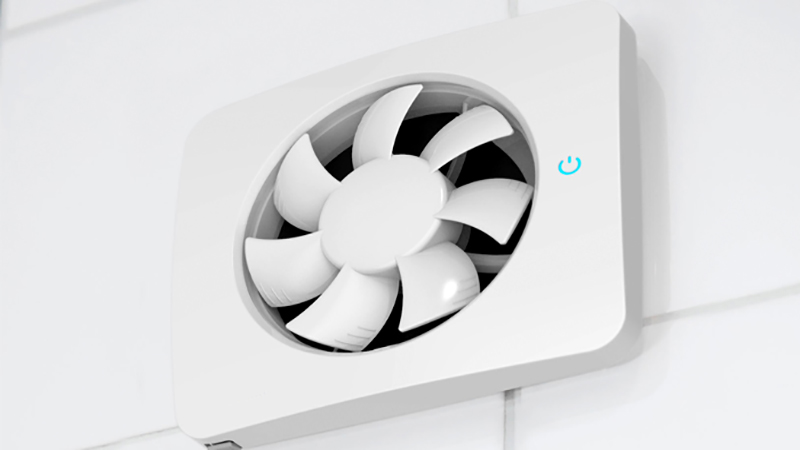
Bathroom extractor fans have many benefits when it comes to humidity and excess moisture in the home. We'll be talking about the uses of extractor fans and the different types available. As well as discussing the best extractor fans for your specific requirements, how they work, and the factors you should consider before investing in a bathroom extractor fan for your home.
If you're currently experiencing issues with excess humidity in your home, you're finding spots of mould, areas of paint peeling or rusting, or you're decorating and looking to prevent humidity complications in the future, this article will be of interest to you.
What Is a Bathroom Extractor Fan?
Extractor fans are something we quite often see on a daily basis but don't necessarily notice. This is because they're most often small and located in a hard-to-reach area of the room.
A lot of the time, we're so accustomed to the noise they make when they're performing their duties that it goes unnoticed. So often, we hear the sound, but we don't think about the important role that the extractor fan has in keeping our home cool, dry and free of damp and mould.
A bathroom extractor fan is a form of ventilation that is fitted to the wall of a bathroom to allow moisture in the air to be removed. They are usually found in small bathrooms and don't have enough space for a working window.
If a bathroom does not have an acceptable form of ventilation, many problems can arise - the most troubling is the growth of mould. When excess water vapour has nowhere to go, it settles on the objects and surfaces around it, making them damp. When these objects and surfaces become repeatedly damp and don't have the means to dry, they become a breeding ground for mould.
Mould can be extremely damaging to your health, and it's best to avoid breathing in toxins released from it. It may look harmless, but mould produces allergens that can cause allergic reactions and produce irritants and sometimes even toxic substances. If you are prone to asthma, mould can even bring on serious asthma attacks, as well as causing sneezing, runny nose, red eyes and rashes.
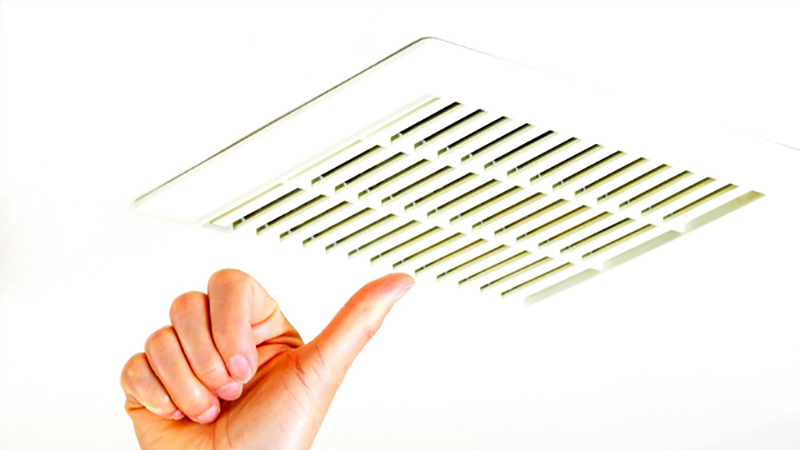
Improper ventilation can also very commonly cause the paint on your walls to peel and crack, as well as allowing rust to form on metal objects around your home. This can be damaging to the structure and materials of your home, as well as the items within it.
In the UK, it's illegal to not have some form of ventilation inside your bathroom. This might sound intense, but in order for you to be safe in your home, you must have a method of maintaining the air quality and preventing bacteria and mould from growing around the premises.
This doesn't necessarily mean that it's essential to install an extractor fan in your bathroom - if your bathroom has sufficient ventilation from an opening window, you may not even need one at all. However, if your bathroom doesn't have an acceptable method of ventilation to allow humidity to be released outside, you will need to install something to do so.
Whether you need an extractor fan or not also depends on the layout and structure of your bathroom. For example, you will often find bathrooms that just contain a toilet can have a small openable window as a source of ventilation.
In contrast, a new build bathroom with a bath and shower must have an extractor fan installed due to newer homes having less ventilation than older builds.
If you are decorating, re-decorating, or struggling with excess moisture in your bathroom, an extractor fan may be the way forward for you.
How Does a Bathroom Extractor Fan Work?
We've all heard the whirring sound of an extractor fan working its magic, but how do they actually work?
Bathroom extractor fans work to remove the humidity and moisture from the room by sucking in the air and water vapour from the bathroom and expelling it through a vent that leads outside. They work very similarly to kitchen exhaust fans, which work to remove smoke from your kitchen when cooking and expel it outdoors and away from the home, leaving you with clean air.
Bathroom extractor fans can either be installed on a ceiling that leads to attic space or a wall where the vent leads outdoors. Inaccurately placing an extractor fan can lead to severe problems within your home. This is because instead of moving the air outdoors, it is simply moved to another area of the home, causing possible damp and mould issues in this location instead.
When extractor fans were initially installed into homes, they were fitted solely to the bathroom ceiling, which vented the water vapour into the attic of the home. However, nowadays, you will most likely find extractor fans placed on the bathroom wall, as this placement runs fewer risks and greater benefits the home.
There is a switch connected to the extractor fan, which, when turned on, powers the device to get to work removing the humidity, leaving you with a less stuffy environment.
For an extractor fan to work correctly, all of the space around the fan must be sealed so no water vapour escapes into the wall spacing. This ensures that all humidity removed from the bathroom is manoeuvred in one direction and to one location - outdoors.
We often notice humidity gathering in the bathroom after a shower when we see condensation on the mirrors and windows. However, switching an extractor fan on before taking a shower can prevent water vapour from settling and causing gradual damage to objects and surfaces.
Types of Bathroom Extractor Fan
When choosing a bathroom extractor fan, it's important to know which type of fan is best for your home. There are a few different options to choose from, and the fan you install will entirely depend on the structure and layout of your bathroom.
The different options of extractor fans for bathrooms are:
- Axial extractor fan
- Centrifugal extractor fan
- Inline extractor fan
This section will discuss the correct extractor fan for each situation and structure, the differences between each type of fan, and the advantages and disadvantages of each type of fan. If you're remodelling or are having issues with damp in your home, this section will narrow down the best options for you.
Axial Extractor Fan
PVC roller blinds are probably the most practical type of bathroom blind. They are available in a huge range of different colours and styles, and they are moisture-resistant, making them perfect for the bathroom. PVC roller blinds can be wiped clean very quickly and easily, and they are very easy to maintain.
An axial extractor fan is the most common type of extractor fan for bathrooms in modern-day homes. So, if you find an extractor fan on the bathroom wall, it's most likely this type, as they are ideal for bathroom structures.
An axial extractor fan works to extract air with the use of a motor. The motor within the fan rotates the blades in a quick motion, which creates a flow of air that is suctioned from one area and expelled into another - much like an office fan or hairdryer. The suction motion created by the fan blades creates kinetic energy, which allows the process to happen efficiently.
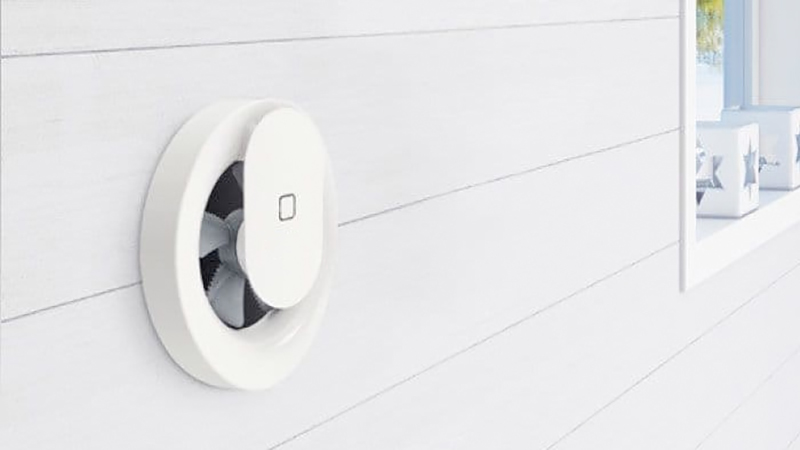
The axial extractor fan extracts the air and pulls it through the impeller, parallel to where the blades rotate. This type of fan is most commonly used for rooms close to the outdoors, where the water vapour does not need to be transported such long distances.
Axial extractor fans are ideal for bathrooms, separate shower or toilet rooms, or smaller rooms in the home. They are installed onto the wall of the room, and the system is connected straight to the outdoors through one wall. As well as wall placements, axial extractor fans can also be installed directly into a window, which reduces the distance the water vapour has to travel, making them more convenient and allows them to work quicker and more efficiently.
Axial extractor fans are relatively cheap compared to other extractor fans, and they are easy to install. They can be noisy when in use at higher speeds, which can be off-putting, but the price and look of an axial extractor usually triumphs over the rest.
These types of fans are also used in office structures and are great at cooling things such as industrial machines and computing.
The advantages and disadvantages of an axial bathroom extractor fan are:
The Good
- Cheaper in price
- Move large quantities of air from the bathroom straight to the outdoors
- Lightweight in build
- Smaller in size
- Use less energy (environmentally friendly)
The Bad
- Tend to be noisy when used at high speeds
- Relatively low pressure - not ideal for high-pressure environments
Centrifugal Extractor Fan
Centrifugal fans are less common in the household, as they can create an extremely powerful high-power flow of air. Therefore, this type of extraction of water vapour is not usually necessary in the average household bathroom.
Due to the high-powered nature, centrifugal extractor fans are also commonly known as 'blowers'. They work on a much larger scale than axial extractor fans, as they are installed around a circular hub that sucks air inside. Pressure is then built up inside the hub, which pushes the water vapour around a 90-degree bend where it continues to be directed to the outdoors.
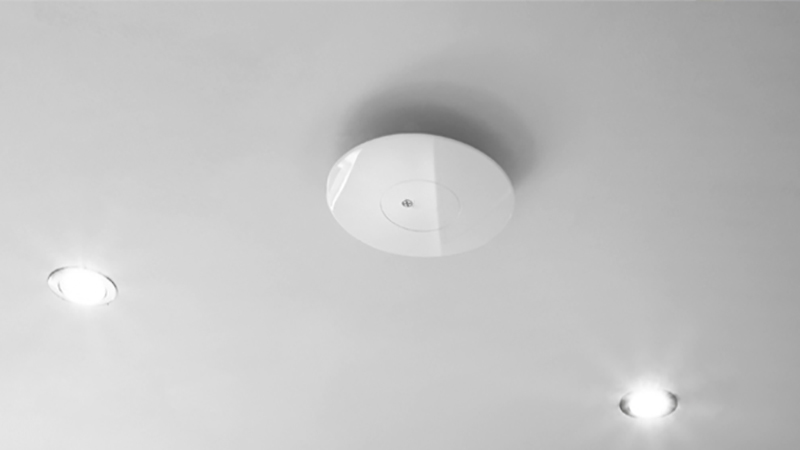
Centrifugal extractor fans are best for structures and rooms that are further away from the outdoors, as they have a higher pressure and can expel air further than an axial extractor fan. So, they are great for bathrooms, and other humid locations, which are central in the home, as the air from these rooms would have to be moved a longer distance through the system to reach the outdoors.
They are also ideal for harsher conditions and more commercial environments like a car wash or your local store with a lack of window space. In addition, you will often find them in air conditioning systems, furnaces, and other high-pressure situations.
The advantages and disadvantages of installing a centrifugal extractor fan are:
The Good
- High pressure - great for expelling air longer distances and for harsher environments
- Very durable
- Very versatile
- Have close blades, which makes them more resilient to damage
The Bad
- Quite expensive
- Heavier than other types of fans
- Can be quite bulky, which can affect the aesthetic of your home
- High energy consumption
Inline Extractor Fan
An inline extractor fan is typically the type of fan that you will see less commonly than the axial extractor fan, however, they hold some great benefits.
An inline extractor fan does not sit directly on the wall or ceiling of the bathroom. Instead, the fan itself is often found further away from the room, such as the attic or roof space. A pipe is then connected from the wall or ceiling of the bathroom up to the fan and then continuing to the outdoors.
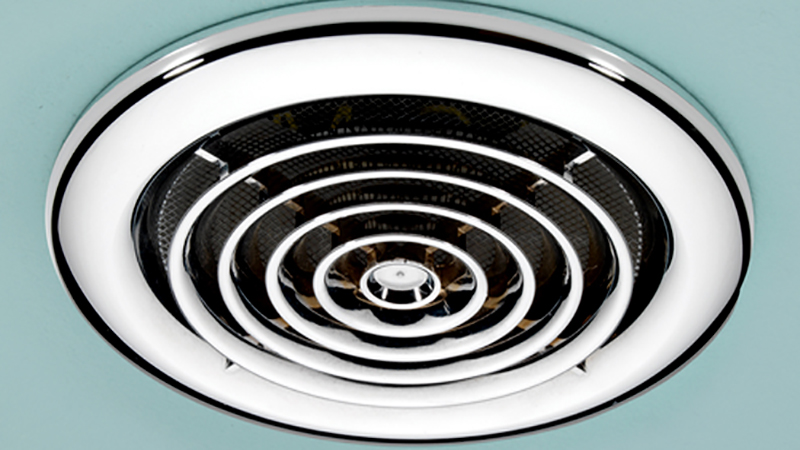
These fans are great for situations where the air must be suctioned and carried very long distances within the home to reach its final destination. Unfortunately, they are a little trickier to install than other types of fans. However, sometimes, in certain home structures, they are necessary to improve the airflow within the house.
The advantages and disadvantages of an inline extractor fan are:
The Good
- Less noise pollution, as the fan is located further away from the desired room
- Relatively high power compared to an axial extractor fan
- Are for rooms that are further away from the outdoors as they have a lengthy duct run
- Can have multiple intake points, meaning that there can be more than one room attached, or more than one location in a larger bathroom
- Great for larger rooms
The Bad
- More difficult to install than other types of fans
- Can be pricier to fit as they require the skills of a professional and more time to install
Best Bathroom Extractor Fan
Looking for some recommendations on extractor fans for your bathroom? We'll be discussing the best extractor fans for each type of fan and will be including some personal preferences such as reduced noise, timed extractors and extractor fans with lights.
Best Axial Bathroom Extractor Fan
Envirovent SIL100T (Silent 100T)
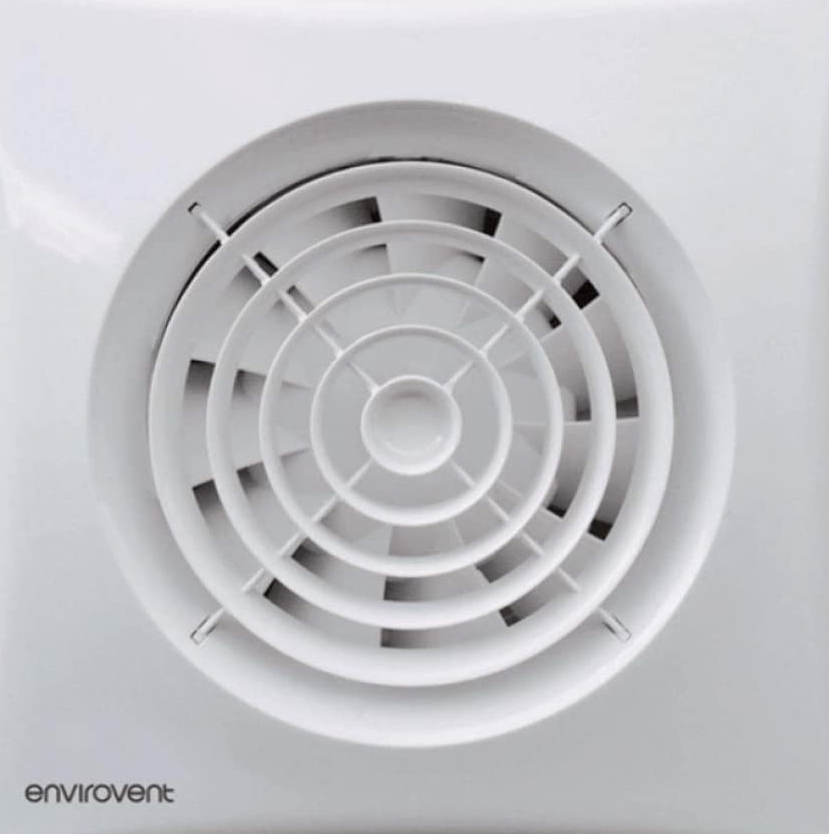
The Envirovent SIL100T is a great addition to most humid rooms. It's got an exceptional reputation for being a silent extractor fan, even portrayed in the name.
It's inconspicuous and modern, blending in well with all styles of rooms with its sleek white appearance. The Silent 100T is easily installed on the wall or ceiling of your bathroom, as long as the location directly connects to the outside world.
As well as a manual timer, the fan has an automatic timer function that can calculate the length of time it should run based on how long it's been used manually. This allows you to go about your day with peace of mind that the SIL100T will rid your bathroom of foul odours without you having to lift a finger.
If you're looking for something quiet, the SIL100T functions at just 26.5 dB at 3m noise, making it one of the quietest axial bathroom fan extractors out there. You also have the option of altering the humidity settings depending on your environment. The fans sensor will continuously scan the room's humidity levels and keep the air at your preferred levels all day long.
Things we liked
- Silent system to completely reduce noise pollution in your home
- Modern and stylish
- Easy to install
- Automatic humidity sensor
- Manual and automatic timer functions
- Great extraction rate (26 litres per minute)
Things we didn't like
- Needs 3 wires in main circuit board for timer function to work. Check your electrics before purchasing.
- Need to clean blades frequently
Best Centrifugal Bathroom Extractor Fan
Manrose CF100T Centrifugal Fan
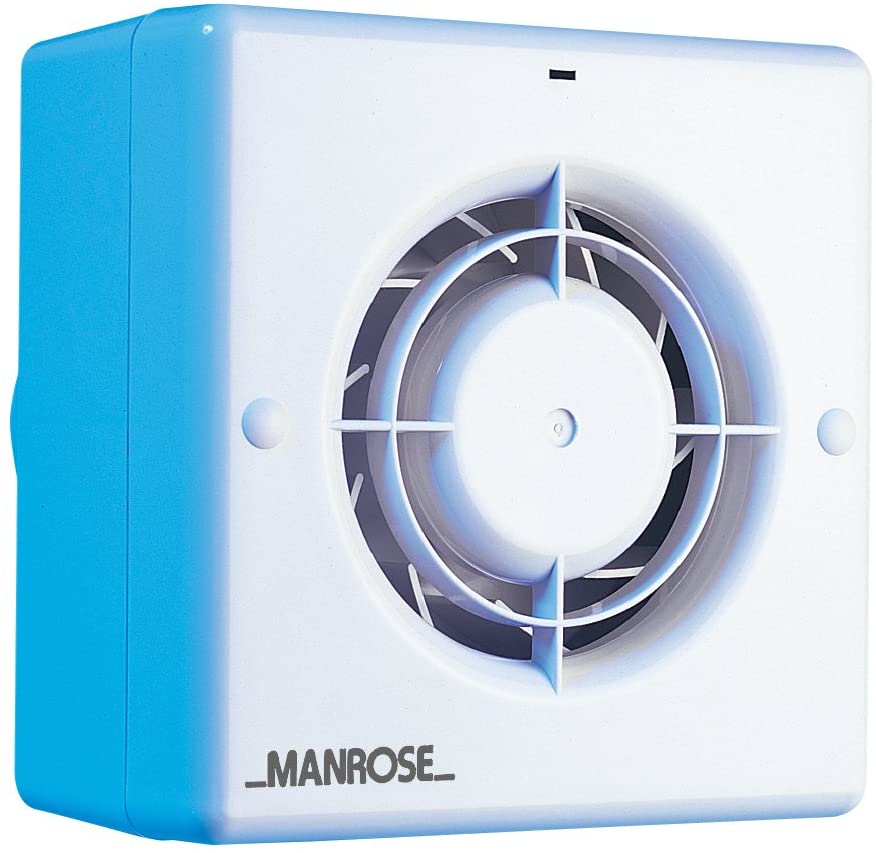
The Manrose CF100T was awarded an "Amazon's Choice Award", giving it a great reputation as a reliable extractor system for your home.
The Manrose CF100T has been designed specifically with bathrooms in mind. It can be installed on either the wall or the ceiling with a cable length of 23cm, giving it a little more room than an axial extractor fan. This means it's perfect for those rooms which are a little bit further away from the outdoors.
As a centrifugal fan, it's expected that this extractor is a bit louder than some other fans on the market. At 39 dB, this fan is quite a bit noisier than some of its competitors. However, the other features make up for where it's lacking in this specification.
The Manrose CF100T removes and expels humid air at a rate of 25 litres per minute, which is pretty powerful for such a small contraption!
It's not an expensive device, though it's built using ABS thermoplastics which makes it a cheaper but more durable option than a lot of other fans on the market currently. So, if you're looking for something that will last, the Manrose CF100T will do just that.
Things we liked
- Reliable - won an "Amazon Choice Award"
- Longer cable length
- Great air expel rate - 25 litres per minute
- Low price
- Very durable
Things we didn't like
- It can be very noisy
Best Inline Bathroom Extractor Fan
Manrose MF100T
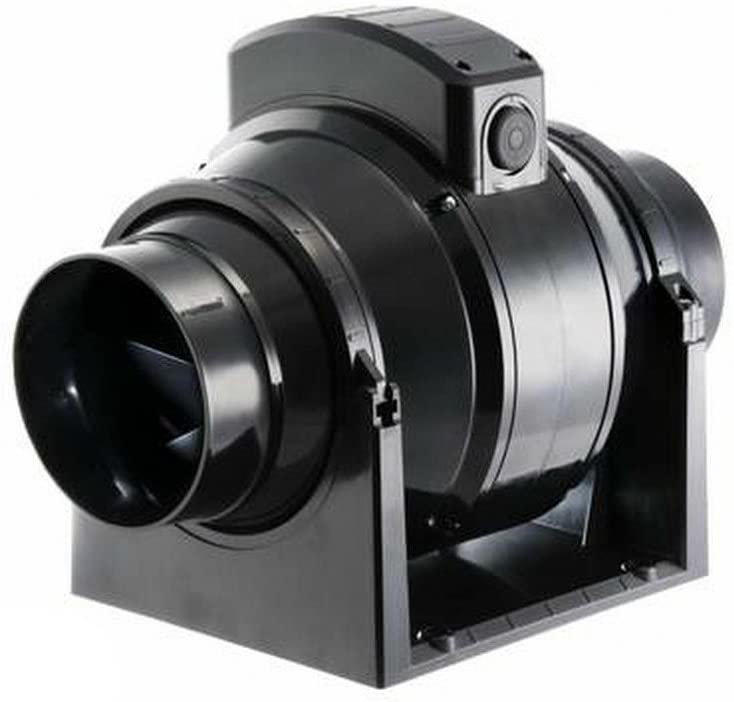
If you're looking for something to install into the ducting and not directly to your plasterboard, the Manrose MF100T is the one for you.
The Manrose MF100T has a very low noise pollution rate, and when pairing this with the fan being placed further away from your bathroom (in the ducts of the attic or roof space), it's pretty much undetectable!
In addition, the sound output is an impressive 25 dB, which is the lowest out of all the extractors we've reviewed. So, if your bathroom is central in your home and you require an inline, this option won't keep you up at night.
The extraction rate of the Manrose MF is 63 litres per second, making it one of the most powerful extractor fans on the market - and it has a built-in timer.
The only downside to the Manrose MF100T is it's a fiddly one to install. Due to this device being attached to your attic or roof space ducting, you will most likely need the help of a professional to install it.
Things we liked
- One of the quietest fans on the market
- Very powerful extraction rate - 63 litres per second
- Built-in timer
- Three speed settings to choose from
- Easy to take care of
Things we didn't like
- Difficult to install - will need the help of a pro
Best Powerful Bathroom Extractor Fan
VENT High Power Inline Loft
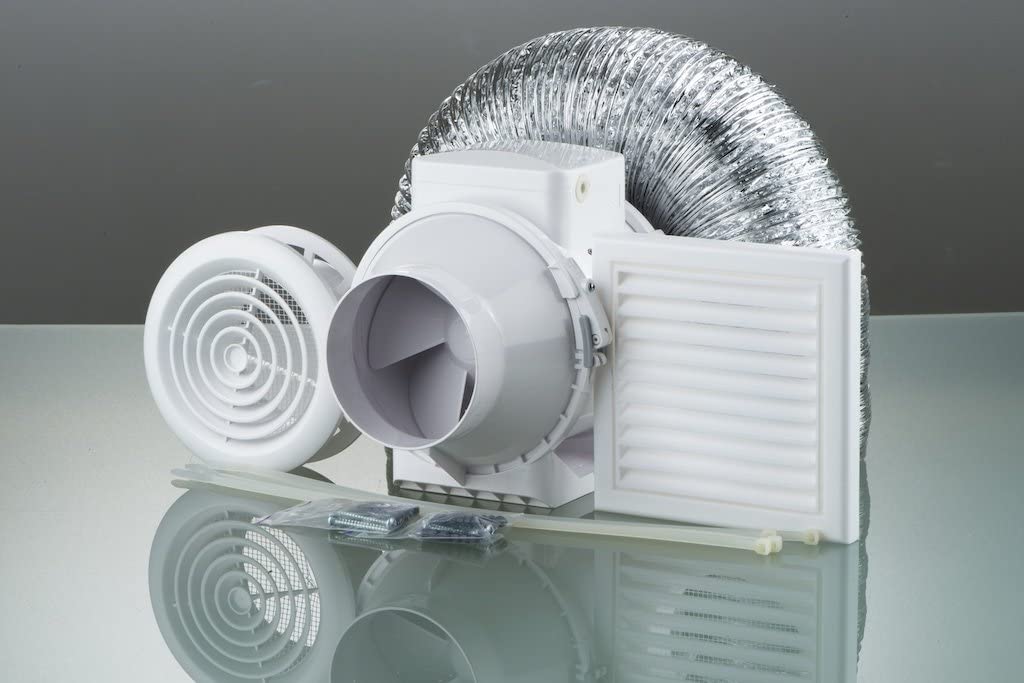
If you're struggling with extreme humidity in your bathroom and you're looking for something extremely powerful, then the VENT High Power Inline extractor is the one for you.
This extractor fan is best for those with bathrooms that don't directly connect to the outdoors or those who are looking to reduce noise pollution with a fan that sits further away.
The VENT High Power Inline extractor is extremely powerful and comes with absolutely everything you'll need to install it - no extra purchases necessary. It arrives with ceiling ventilation, ducting, clips and wall outlets.
However, the downside of this fan is that it's difficult to install, meaning you're most likely going to have to hire a professional to install it, costing you that little bit extra.
This fan operates with a run-on timer, so it'll continue to work for a little while after you've left the room to ensure the room stays fresh and water vapour free for your next bathroom trip.
Things we liked
- Very powerful - expels air quickly and efficiently
- Sits further away from the bathroom, so less likely to be heard
- It comes with the full kit to install
- Functions with a run-on timer
Things we didn't like
- Not the quietest system on the market
- Most likely, you'll need the help of a professional to install
Best Silent Bathroom Extractor Fan
Blauberg UK CALM 100 T Environment Silent
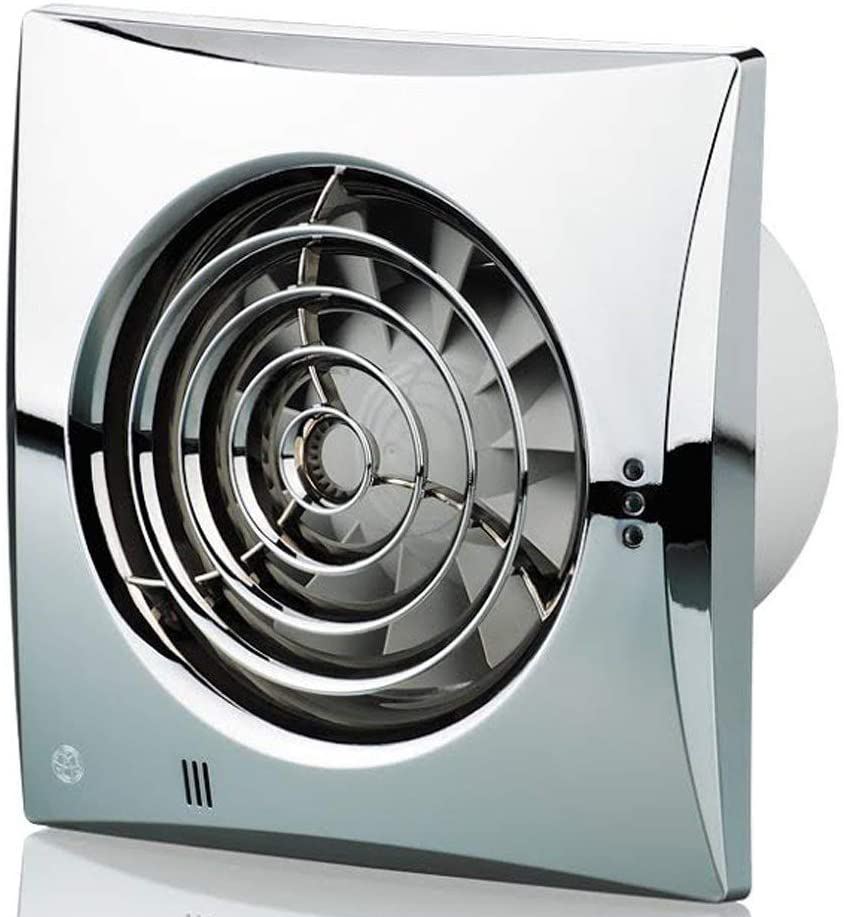
The Blauberg UK CALM 100 T is an extremely quiet system that works using German techniques to ensure noise pollution is reduced dramatically.
The Blauberg UK CALM uses an anti-vibration method which allows it to function as quietly as possible, at an extremely impressive sound rate of only 25 dB.
This is one of the easiest and most efficient systems on the market, as it requires zero installation procedures. Simply find a socket in your home, plug it in and voila!
The simple nature of the Blauberg UK CALM means that it can be used in any area of the home that is a little too humid for your liking. You can purchase multiple and have them in any area you desire!
The Blauberg UK CALM is extremely small, making it a compact and discreet feature in any room. Its sleek design gives it that little bit of modern edge.
Things we liked
- Very quiet - 25 dB
- No need to install - plugin system
- It can be easily used in any room of the home where there is a power source
- Compact and unobtrusive
- It can be mounted on the ceiling or wall
Things we didn't like
- It still makes a little noise, not completely silent
Best Bathroom Extractor Fan with Light
Panasonic Whisperfit
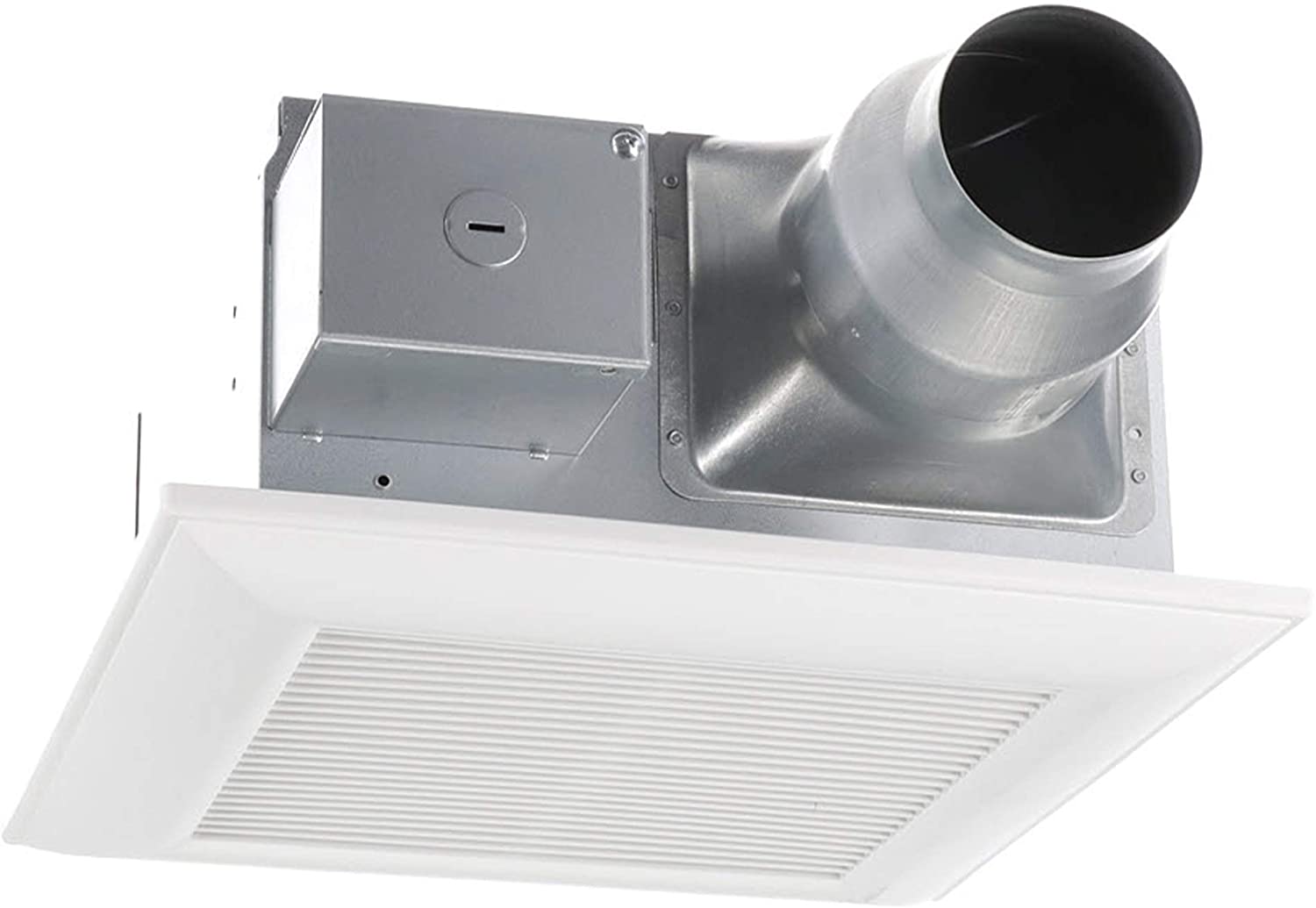
Looking for an extractor fan that multitasks? The Panasonic Whisperfit works as both a bathroom extractor fan and a working bathroom light. The light fixture within the system is a 10-Watt LED bulb that gives you a dimming option if you're looking for less light.
The Panasonic Whisperfit's bulb allows you to dim it to just 1-Watt, for those nighttime trips to the bathroom where your eyes aren't ready for bright lights.
It's easy to install, so it should be quite straightforward to fit if you're handy with tools. There is also a built-in speed selector, so you can control how fast it works and how much humidity is removed from your bathroom.
As referenced in the name, the Panasonic Whisperfit is extremely quiet, with a noise rate of just 0.3 sones. So, you can enjoy that relaxing bubble bath without the intense whirring of the standard extractor fan.
Things we liked
- Built-in LED light
- LED light is dimmable
- Easy to install, no need for a professional
- Built-in speed selector
- Very quiet - as stated in the name
Things we didn't like
- It can be quite costly
- No humidity sensor
- It only fits a small selection of vents, not much variety in size
Best Bathroom Extractor Fan with Timer
Manrose QF100T Quiet Extractor Fan with Timer
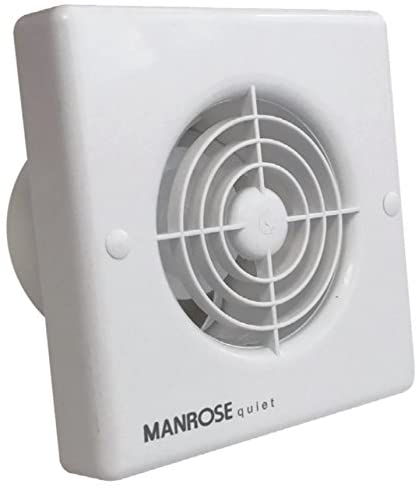
As you can tell, we're big fans of the Manrose brand - they never fail to please.
The Manrose QF100T Quiet Extractor Fan is a great option for anyone looking for a bathroom extractor fan with a built-in timer. The timer works manually and automatically, depending on the method you prefer.
The Manrose QF100T is on the quieter end of the spectrum when it comes to extractor fans, releasing only 27 dB of noise pollution when in use. It extracts air from the desired room at 21 litres per second, which, although isn't the highest, it does its job pretty well.
This system is a great option for most bathrooms, as it can be installed on either the wall or the ceiling - as long as the area is directly connected to the outdoors. It's designed to withstand the test of time, with a base of thermoplastics adding high durability to the product. This isn't your bog-standard, cheap extractor fan, this is the real deal.
Things we liked
- Built-in timer - automatic and manual
- Quiet system - releases 27 dB of sound
- Good extraction rate - 21 litres per second
- Easy to install
- Can be mounted on wall or ceiling
- Built from sturdy materials
- Very energy-efficient compared to other brands
Things we didn't like
- The inside spring is a little bit flimsy, however, it still serves its purpose
What to Consider Before Buying a Bathroom Extractor Fan
There are multiple factors that you must consider when purchasing an extractor fan for your bathroom. These factors are:
Room Size
The size of the room greatly impacts the type of extractor fan you should install. When choosing an extractor fan for a small bathroom, the most common answer is the axial extractor fan, as this is most commonly used in modern builds, and it is a great all-rounder.
However, if your bathroom wall does not directly connect to the outside, you may need to consider fitting a centrifugal or inline extractor. Centrifugal extractors may not be necessary for the average bathroom, as they tend to be noisy and use a lot more energy than other types of fans.
If your bathroom is large and not directly connected to the outdoors, an inline extractor may work best for you. As they allow for multiple intake points within the same room, the duct's length is longer than that of a centrifugal.
Length of Duction
If your bathroom is not directly connected to the outdoors and is more central in the home, an axial extractor would not be suitable. This type of room would require the longer duction of a centrifugal or inline extractor.
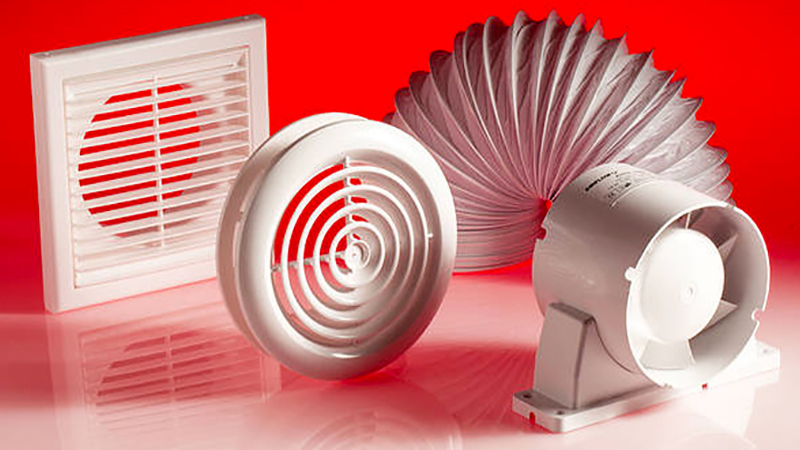
The choice between these two options is entirely based on the distance from the bathroom to the outdoors. If your bathroom is very central in the home and not near the outside environment, you will most likely need the long duction of an inline extractor.
Installation Position
Before buying an extractor fan, you will need to look at the position in which it will be installed. For example, if your bathroom has a wall directly connected to the outdoors, a simple axial extractor can be fitted to the plasterboard.
If your bathroom does not directly connect to the outdoors, the extractor fan would more likely need to be fitted to the ceiling. In this case, you would most likely need an inline extractor fan or a centrifugal.
Before buying, consider the size of your bathroom and the positioning of the extractor points. For example, keep your extractor close to the bath or shower. If you have more than one appliance that creates humidity, consider fitting multiple intake points with an inline extractor.
Noise Pollution
If you're not a fan of the noisy whirring of the average extractor fan, or you are worried about the noise pollution it may cause the people around you, consider installing an inline extractor fan.
With this type of fan, the blades themselves are further away from the bathroom, usually located in the attic or roof space. The further away from the blades, the less noise pollution all around.
FAQs
How do you wire a bathroom extractor fan?
Before wiring an extractor fan, ensure that the mains electricity is turned off. Re-wiring an appliance with the life circuit running can result in injury or even death.
Firstly, familiarise yourself with the colour codes of the wires. Wiring colours are usually as follows:
- Blue: Neutral
- Red: Permanent Live
- Yellow: Switched Live
Connect the wires in the extractor with the corresponding colours in the wall or ceiling. If you are unsure, consult the help of a professional - wiring without knowledge of how to do so can result in accidental damage to the property or injury to yourself.
How do you clean a bathroom extractor fan?
To clean an extractor fan, first, remove the filter from the appliance.
Next, place the filter in hot, soapy water, or for a more natural approach, use a mixture of water and white distilled vinegar. Leave the filter to soak for at least 30 minutes before using the rough side of a sponge to remove any excess dirt.
If you're finding it difficult to remove the excess dirt, try sprinkling some baking soda over the tougher areas and continue to scrub. Then, use a toothbrush to remove any dirt in hard-to-reach areas, rinse, and leave the filter to air dry. Once completely dry, simply place the filter back into the extractor fan.
What type of extractor is best for a small bathroom?
If your bathroom is small, the most common bathroom fan extractor to install is an axial extractor. However, this also depends on the location of your bathroom within the home. If your bathroom is not directly connected to the outdoors by one wall, it may be necessary to fit an inline extractor or a centrifugal extractor.
What is the quietest type of extractor fan?
If you're worried about noise pollution within your home, the best type of extractor fan to install is an inline extractor fan. This type of fan positions the blades and motor function away from the bathroom, such as the attic or roof space, which results in less noise pollution.
What type of extractor fan uses less energy?
If you're looking for an extractor fan that will save you money in the long run, the best option for your home is an axial extractor.
These extractor fans use a lot less energy as they are low-pressure extractors. This makes them a great option for reducing your carbon footprint and saving money compared to other types.
Sources
- https://www.simplybusiness.co.uk/knowledge/articles/2017/10/how-to-clean-the-extractor-fan-filter-in-your-kitchen/
- https://www.plumbworld.co.uk/blog/everything-you-need-to-know-about-bathroom-ventilation
- Bathroom-ventilation-guide
- https://www.tradewindsimports.com/blog/bathroom-extractor-fan-run-outside/
- https://www.heatpumpsource.co.uk/blog/best-bathroom-extractor-fans/
- Best-bathroom-exhaust-fan-with-light
- Bathroom-extractor-fans
- https://heatingforce.co.uk/blog/bathroom-extractor-fan/
- https://www.expertreviews.co.uk/home/1407799/best-bathroom-extractor-fans

